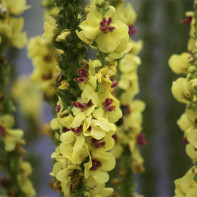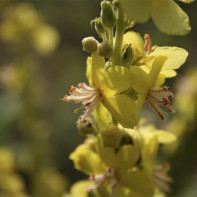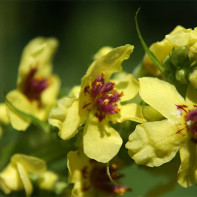Cowpea: medicinal properties and contraindications
In nature there are many different useful plants that can independently spread and grow in almost all territories. One such medicinal herb is mullein, a representative of the flora, which belongs to the Norichnik family.
- Chemical composition
- How it looks and where it grows
- Types
- Collection and storage
- Therapeutic properties of the herb mullein
- For Women
- For Men
- For Children
- Cowherd in folk medicine
- Types of medicinal compositions
- Infusion
- Infusion
- Decoction
- Tea
- Oil
- Ointment
- Cosmetic applications
- Contraindications for use
This plant has long been known in folk medicine for its medicinal qualities. Almost all parts of the herb are used to treat a diverse group of diseases, including pathologies of the respiratory system and gastrointestinal tract, skin and mucous membranes. Cowpea is used both internally and externally, and has few contraindications.
Chemical Composition
The main curative effect of mullein is based on the fact that it contains high concentrations of iridoids, which are represented by harpagide and its acetate, as well as aucubin and katalpol. These compounds are antioxidant substances designed to slow down the aging process at the cellular level. Iridoids are able to exert antimutagenic effect that allows preserving genetic material and DNA chains intact. In addition, this group of substances has anti-inflammatory and immunostimulating properties that strengthen the body's defense function, eliminate inflammatory processes that are usually accompanied by swelling, fever and pain. Also iridoids can have hypotensive effect and stimulate bile synthesis.

In addition to this group of substances, mullein also contains other valuable components. So, in the plant are found mucus, which has a coating, emollient and protective effect on mucous membranes. The mucus promotes faster healing of the mucous membranes of the digestive tract, as well as improving the excretion of sputum from the bronchi.
The sugars in the herb are broken down to glucose, resulting in a source of energy for the human body. These substances regulate metabolic processes, stabilizing tissue nutrition and providing all cells with energy.
Saponins contained in cowpea are highly active elements of chemical origin, which contribute to the purification of the lungs, normalization of urine production and excretion. They are also characterized by anti-sclerotic properties, inhibit the development of cancer cells.
Flavonoids are designed to restore the normal functioning of the nervous system, improve concentration. In addition, this group of compounds increases the elasticity of blood vessel walls, protecting them from fragility. These substances also prevent atherosclerosis and improve peripheral circulation. They are characterized by anti-inflammatory and antimicrobial action.
Essential oils stimulate intestinal and biliary tract activity, act as a sedative, improve the discharge of mucus from the lungs.
Cowpea contains gum, which acts as an adsorbent that absorbs toxic substances when it enters the lumen of the digestive tract. They envelop the mucosa, regulate appetite, restore intestinal microflora, and have an anti-inflammatory effect.
Thanks to coumarins contained in cowpea, the plant is endowed with antiseptic and astringent qualities, which can stimulate the healing process of wounds. Also, these components have a moderate diuretic effect, act as a prophylactic of thrombosis.
This medicinal herb contains organic acids, which are also characterized by anti-inflammatory, antiseptic, antifungal and astringent qualities.
Tanin, found in mullein, is a tannin that has anti-inflammatory, anti-exudative and regenerative properties. In low concentrations it provides healing of gastrointestinal mucosa and fastening of stool, in high concentrations it acts as an irritant that enhances peristalsis.
The mineral composition of cowpea is represented by K, Ca, Mn, Fe, Li, Mg, Cu and other components that take an active part in metabolic processes.
The product also contains vitamins such as retinol, tocopherol, ascorbic acid. They are responsible for tissue renewal, characterized by antioxidant properties, strengthen the body.
Cowpea flowers contain plant ash, which is endowed with anti-inflammatory and blood-thinning qualities.
What it looks like and where it grows
Despite the fact that the royal scepter, as it is also called cowpea, is a wild plant, it has a rather attractive appearance during the flowering period.
The stem of the grass is erect, covered with ashy hairs that resemble thick down. The pointed leaves are about 15-30 cm long and about 5-10 cm wide. The leaves grow along the entire length of the stem, pointing upward.
The abalone has bright yellow flowers of small size. The plant blooms from the second year of life. This herb can be found in almost every region of the world, but its natural area of distribution is Eurasia and the Atlantic archipelagos along Africa and Europe. The grass is undemanding to the soil, it grows and grows freely near roadsides, and can also bloom on sandy and stony areas. If the grass gets on chernozem and other types of fertile soil, however, it begins to be sick and soon dies.
Types of
Royal scepter is the tallest of all the varieties. It has the longest flowering time. In medicine it is used as an analgesic. This species is most effective against hemorrhoids and lung diseases. In addition, this type of cowberry has diaphoretic, expectorant and diuretic properties, which allows it to be used in the production of certain medicines.
A species such as bear's ear helps to cope with inflammatory processes, as well as dilates blood vessels and eliminates cramps.
Hybrid bromegrass is probably the most unpretentious. It is able to survive even in severe drought and severe frost, but prefers open, sunny terrain. The inflorescences have a rich yellow color, which are presented in the form of a panicle or spike. Distinguished by its wound-healing and insecticidal characteristics.
The panicle mullein is easily distinguished by the presence of toothed leaves. This variety blooms throughout the summer. It is used to reduce blood pressure.
The dense-flowered type can reach 0.8 m in height, is characterized by felted pubescence, the leaves have an oblong shape. It also blooms from June to August.
Purple mullein differs from its brethren in that it belongs to the perennials and has flowers of purple color. This species blooms briefly - from June to early July. In folk medicine it is used to stimulate the heart muscle and improve bowel motility.
Black bromegrass is characterized by a spindle-shaped root and can usually grow up to 1 m in height. The flowers are gathered in bunches and give off a sweet aroma that persists even in the dried raw material. May bloom throughout the summer. For therapeutic purposes, the flowers are used, which can treat respiratory diseases.
The Olympic species of the plant is also perennial, can reach a height of 2 m. The inflorescences are small, the foliage is gray in color. The herb blooms only in July. The product is used as a remedy for ulcers.
Collection and storage
If you collect and dry the medicinal raw material incorrectly, it is very easy to lose its medicinal qualities. So, collect the plant only in dry, sunny weather, after evaporation of dew. Fallen leaves should not be collected, as they have not kept anything useful. Raw material without inflorescence calyxes will be of high quality.
When collecting grass you should make sure that the raw material does not turn white, it should retain its golden color. Dry mullein can be under a shed or in a ventilated room. The dried herb should be packed in an airtight container.
For medicinal purposes, flower corolla is most often used. Common bromegrass (abalone) is usually harvested for medicinal purposes. It blooms between July and August.
Other parts of the herb, such as the root and leaves, are also used in folk medicine recipes. Raw materials from a single plant can be harvested for a month, or even longer, because it has a fairly long flowering period. If you need to collect the leaves or flowers, it is better to choose the end of summer.
Medicinal properties of the herb cowslip
First of all, it should be noted that the plant is used to treat bronchitis and bronchial asthma. Cowdrop is useful in catarrh of the respiratory organs, flu, tuberculosis, especially when the pathology is accompanied by an excruciating cough, because the grass has expectorant qualities. It helps to liquefy sputum and remove it from the respiratory tract. The plant is also used as a mild diuretic.
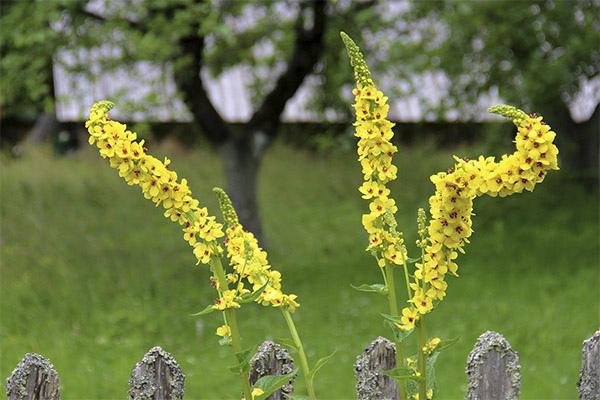
Cowpea also has antispasmodic, anticonvulsant, astringent, styptic, exfoliating, antifungal, antiseptic and wound healing qualities.
With the help of this plant you can treat diseases of the mucous membranes in the mouth, stomach and esophagus, as well as in the intestines. Such plant raw materials can protect the mucous membranes from external negative influences, reduce pain, relieve swelling. Fights cowpea and with influenza viruses.
Since ancient times, people have noticed that if you put the flowers of the plant to the place of the bruise, it protects against the appearance of a bruise. If bruises have already appeared, you can tape the flowers to the sore area, which will accelerate the process of resorption of the hematoma. Consequently, this raw material is used in dermatology, namely for burns, frostbite, acne, eczema, furunculosis. Recovery is provided by improving the peripheral circulation, which normalizes the flow of blood with all the necessary components to the site of injury.
Bronchopulmonary diseases, including obstructions in bronchitis, laryngitis, pneumonia can also be treated with cowpea. In addition to treating coughs, abalone also increases immunity and provides a quick recovery after a cold. The plant helps to cope with shortness of breath with bronchial asthma, inflammatory processes of the mouth, such as stomatitis, periodontal disease, gingivitis.
The rich vitamin composition contributes to the elimination of edema. Thus, the plant helps to remove excess salt deposits from the body, while relieving acute inflammation in the joint. Cowpea is recommended for arthritis, gout, neuralgia, rheumatism.
The high content of mucus and tannins enables the use of herbs for gastritis, colitis of various etiologies, lack of pancreatic enzymes. Popular ration in the treatment of hemorrhoids.
In addition, mullein has a sedative effect, normalizing the activity of the brain, stabilizing the nervous system, increasing stress resistance and concentration.
For women
In gynecology, mullein is often used. It is indicated for inflammation of the genitals, in the menopausal period, the product allows to regulate high blood pressure and prevent the development of atherosclerosis. However, it is necessary to take into account the peculiarities of the use of this plant for medicinal purposes, since among the fairer sex there are a number of restrictions to the reception of such a herbal remedy. For example, you should remember that mullein is contraindicated during pregnancy and breastfeeding, because it has an irritant and tonic property.
During menstruation and in the period after childbirth, even if the baby is on artificial feeding, it is also contraindicated to use such a herb due to the fact that it acts as a blood thinner.
Cowpea flower powder is used as a powder to heal cracked nipples. The first step is to treat these areas with an oily solution of retinol, fish oil, or carrot squeeze. The use of abalone oil is allowed. If breastfeeding continues during therapy, you should wash your nipples with warm water beforehand.
In addition, in gynecology, scepterous cowpea is used internally in the presence of inflammatory diseases. In this case, you need to prepare a decoction of 1 tbsp of raw materials, poured with a glass of boiling water. The resulting solution should insist until it cools, after which it should be taken by 1 tbsp. after meals three times a day.
With menopause, accompanied by atherosclerosis and hypertension, you can prepare the same infusion, but in this case you need a more concentrated solution, that is, a glass of boiling water will need 2 tbsp. raw materials. Despite the fact that the solution of cowpea is actively used for gargles, douches with it should not be done, because for this purpose herbs with a higher concentration of tannins are used.
For men
In andrology, there are not any recipes on the basis of cowpea for the treatment of diseases of the male genital system. However, due to the fact that often prostate disorders are accompanied by hemorrhoids, indirectly the plant can contribute to the treatment of this gland in the treatment of hemorrhoids. Thus, mullein will provide an increase in the secretion of this gland.
Such a plant raw material is one of the most effective ways to cure inflammation of hemorrhoidal nodes. Compared with a number of analogues, this product eliminates inflammation in these tissues the fastest, preventing bleeding and eliminating pain in the anus area. Medicinal compositions are prepared from cowpea, designed to kill pathogenic microflora in the area. They help to protect against the development of bacterial complications and irritation of the mucous membrane and skin. In this case, anal ulcers, erosions and tears are covered with a kind of protective film, as a result of which the recovery process is accelerated.
You can also do sitting baths. In this case, you will need to prepare a decoction. To do this, you need to take 50 g of dried flowers and 50 g of roots of cowpea. Pour the resulting mixture into 3 liters of boiled water and simmer over low heat for 20 minutes. Pour the resulting decoction into a suitable container for sitting baths. When the liquid cools to 40 degrees, sit in the basin so that the entire anus is completely immersed in the healing solution. The procedure should last about 15 minutes. To get good results, you need to do such baths 3-4 times a week before going to bed. Procedures are prohibited when bleeding from inflamed nodes, as such a solution has a negative effect on the body and only worsens the condition.
For children
Recently, it is not recommended to give children cowpea for internal use, but folk medicine has preserved recipes for the preparation of healing compositions intended for the treatment of severe cough, whooping cough, inflammation of the bronchi and lungs with heavily expelled phlegm.
To obtain the syrup, you need 1.5 tbsp. flowers of grass mixed with 2/3 tbsp. rhizome of marshmallow and boil them in 0.3 liters of water for 10 minutes. After that, filter the solution and mix it with a glass of sugar. Next, cook the mass until a thick syrup. Give the ready remedy to children 1 tsp. 4-5 times a day with a strong cough.
To prepare a healing decoction, you need 1 tsp. herbal raw materials pour 0.5 liters of water and boil for 1 minute, filtered and drink 1 tbsp. three times a day after meals. You can add milk instead of water.
Cowpea in folk medicine
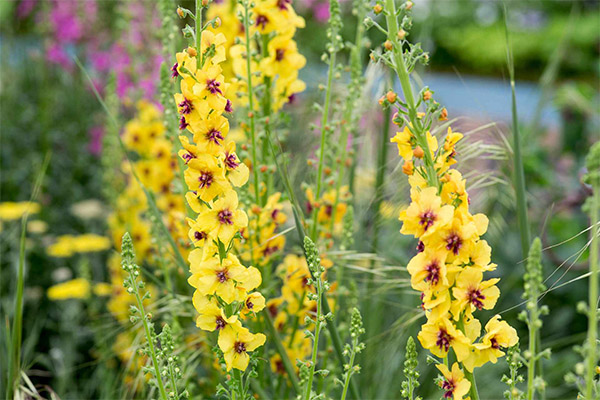
- With bronchial asthma and sick lungs is an effective remedy, for which it is necessary to pour 3 tbsp of raw materials 500 ml of boiled hot water and insist the mixture in a thermos. The resulting amount of liquid is divided into three parts, which should be drunk during the day.
- For the treatment of pathologies of the stomach and intestines, a remedy of 40 g of dried flowers and 1 liter of boiling water is useful. Brew and let the mass to infuse. The ready solution to drink 50 ml every two hours.
- To make a soothing composition, you should drink the flower decoction with the addition of a small amount of natural honey.
- As noted above, mullein has diuretic qualities, therefore, it is useful for gout and kidney stones. To cope with these ailments, it is necessary to make a healing decoction. Such an infusion should be drunk in the morning on an empty stomach, and during the day before each meal. Use about 200 ml per day.
- An effective remedy for diarrhea will be an infusion of the inflorescences of the flowering plant. Take the remedy several times a day for 20 ml.
- Usually cowpea is used in combination with other medicinal herbs. To obtain a diaphoretic solution, it is necessary to mix 1 part each of the flowers of royal scepter, black elderberry and mallow, and 2 parts each of linden and raspberry. All components should be mixed, measure 1 tbsp. of the resulting mixture and boil in 500 ml of water. The resulting solution to drink hot before going to bed.
- In the form of compresses and rubbing mullein is used for sciatica and rheumatism. To do this, pour 1 tbsp of raw materials 250 ml of vodka. Let this mixture to infuse in a dark place for two weeks.
- With ulcers and purulent wounds, an effective ointment will be made of 5 parts of the seeds of the culture and 10 parts of butter.
Types of medicinal compositions
Cowpea is a raw material for obtaining medicines used for various diseases. This plant is used to make decoctions and infusions for internal use, as well as remedies for external use. These compositions have immunostimulatory, antiviral, analgesic and anti-edema characteristics.
Dried above-ground parts, chopped to 5 mm, and roots - to 3 mm are used to obtain dosage forms.
Infusion
Infusion of cowpea is effective in the therapy of pulmonary pathologies, including pneumonia, asthma and even pulmonary obstruction.
To make a therapeutic composition, you need 1 dessert spoonful of dried raw materials in the form of flowers, pour 200 ml of steep boiling water. This solution to infuse for a quarter of an hour, and then strain. The finished product is divided into three doses and drink before meals.
Tincture .
Alcoholic tincture helps with joint and muscle pain. It is used as an external therapeutic agent for rubbing.
To obtain this preparation, you need 1 tbsp dried raw material mixed with 10 tbsp of vodka. Give the mass to infuse for three days in a dark place with periodic shaking. At the end of this period, strain the liquid.
Decoction
Decoction on a herbal basis is useful for the treatment and prevention of high blood pressure, atherosclerosis, cystitis, as well as diseases of the digestive system. Received according to this recipe, you can rinse your mouth with stomatitis and sore throat.
For the manufacture of funds should be 1 tbsp dried and crushed raw materials, pour 250 ml of boiling water. This mass put on the stove and over low heat bring to a boil. Boil the mixture for two minutes. After this, the composition should infuse for half an hour. Filtered liquid to drink three times a day, 1 tbsp.
Tea
To make a healing tea, you need 2 tbsp. Dry raw materials mixed with boiling water, leave for a few hours. Then strain the mass.
Such a drink will help to improve the activity of the digestive tract. Tea from cowpea is used for constipation, diarrhea. In addition, it is able to remove toxins from the body.
With sleep disorders, it is recommended to drink a tea of cowpea leaves before going to bed.
Oil
There is a popular belief that mullein can be used for urinary incontinence. In fact, such a remedy is used externally to eliminate ear pain, in this case, the composition is buried in the ear, as well as in joint pain, with the oil should be rubbed in the sore place. Also such a mixture is suitable for compresses for dry skin and dry eczema.
To obtain vegetable oil 3 tbsp. fresh flowers of the herb should be placed in a container of glass, pour 100 ml of olive oil and insist in the sun with daily shaking. Repeat this procedure for a month, after which the remedy will be ready for use.
Ointment
With the help of cowpea ointment you can cure wounds that do not heal for a long time, festering, soaking and trophic ulcers.
To create such a healing remedy, it is necessary to grind the dried seeds of the culture to a powdery consistency. The resulting powder should be mixed with butter in a ratio of 1:2. The ready ointment is applied to the affected areas under a bandage, doing it twice a day.
Cosmetic applications
In cosmetology, the qualities of cowpea are valued. After all, the plant has antifungal, emollient, moisturizing, antibacterial, nourishing, soothing and antiseptic properties.

- To cleanse the skin, it is recommended to make an infusion of 1 tbsp of inflorescences and 100 ml of boiling water in the morning and evening. Allow the mixture to infuse for 30 minutes, then filter the liquid. Store the resulting composition in the refrigerator. Use the remedy for a long time, alternating with parsley infusion.
- To prepare a rejuvenating mask, collect 1 tbsp. stamens from freshly picked flowers and grind them in a porcelain mortar. The resulting porridge should be mixed with 5 g of honey and 10 g of sour cream. The resulting composition applied to the face for 15 minutes. After that wash your face with warm water. You can use for this decoction of parsley, it has a whitening property. Cosmetic means on the basis of cowpea can be used no more than 10 days, then make a one-week break, then repeat the course.
- Moisturizing mask is made from 15 ml of flower infusion, 5 ml of natural honey and the same amount of olive oil. This mixture should be applied directly to the face or to saturate a tissue mask and put it on for 10-15 minutes.
- Decoction of leaves and inflorescences of mullein can be used as a balm for hair. In this case, the hair should be soaked with the healing infusion, cover with a cap for 30 minutes, and then wash your hair the usual way. The decoction can be applied as a rinse.
- To accelerate hair growth and eliminate dandruff, you need to mix 30 ml of infusion and 15 ml of burdock oil. Moisten the tresses with the resulting mixture. The remedy should act for half an hour, then you need to wash your head. Such a procedure should be repeated once a month.
- To prepare a remedy for skin care, you should take a bath with the addition of 10 drops of royal scepter oil. This plant has a rich complex of beneficial substances.
Contraindications for use
Despite a number of useful properties, all parts of cowpea have certain contraindications. So, you can not use the raw material with a tendency to allergies, in the period of lactation and carrying a baby.
The herbal remedies prepared on the basis of this herb should be well filtered so as not to cause irritation and upset the gastrointestinal tract. Under no circumstances should the seeds and remedies from them be used internally, as this part of the herb is toxic.
«Important: All information on this site is provided for informational purposes only information on this site is provided for informational purposes only. Consult with a health care professional before using any of the recommendations. health care professional before using any of the recommendations. Neither the editors nor the authors shall be liable for any possible harm caused by materials."



